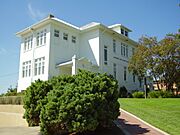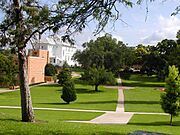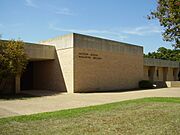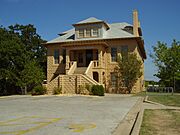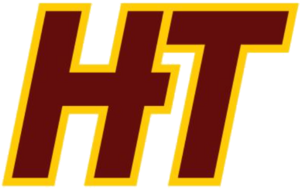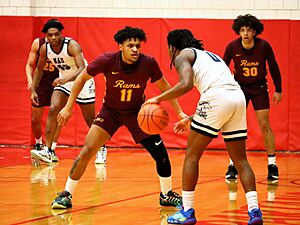Huston–Tillotson University facts for kids
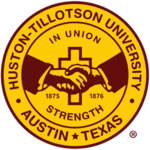 |
|
|
Former names
|
Tillotson Collegiate and Normal Institute (1875–1952) Samuel Huston College (1876–1952) Huston–Tillotson College (1952–2005) |
|---|---|
| Type | Private historically black university |
| Established | 1875 |
| Affiliation | UNCF |
|
Religious affiliation
|
United Methodist Church, United Church of Christ |
| Endowment | US$11.5 million |
| President | Melva K. Wallace |
| Provost | Archibald W. Vanderpuye |
| Students | 1,160 |
| Undergraduates | 968 |
| Postgraduates | 55 |
| Location |
,
U.S.
30°15′53″N 97°43′21″W / 30.2648°N 97.7224°W |
| Campus | 24 acres (9.7 ha) |
| Colors | Maroon & gold |
| Nickname | Rams |
|
Sporting affiliations
|
NAIA – RRAC |
 |
|
|
Huston–Tillotson College
|
|
| NRHP reference No. | 100007662 |
| Added to NRHP | April 22, 2022 |
Huston–Tillotson University (HT) is a private university in Austin, Texas. It is a historically Black university, meaning it was founded to educate Black students during a time of segregation. The university opened in 1875 and was the first place for higher education in Austin.
HT is connected with the United Methodist Church and the United Church of Christ. It is also part of the United Negro College Fund, which helps students attend college. Huston–Tillotson University offers many different degrees. Students can earn bachelor's degrees in areas like business, education, science, and technology. There is also a master's degree in educational leadership.
Contents
University History
Huston–Tillotson University was formed in 1952. This happened when two older schools, Tillotson College and Samuel Huston College, joined together.
Tillotson College's Beginnings
Tillotson Collegiate and Normal Institute started in 1877. It was a school for both boys and girls. The American Missionary Society of Congregational churches founded it. The school was named after George Jeffrey Tillotson. It officially opened on January 17, 1881.
From 1926 to 1935, Tillotson College was a school only for women. Many leaders helped guide the college over the years. J. T. Hodges became the first African American president in 1924.
Samuel Huston College's Beginnings
Samuel Huston College began in 1876. It was started by a Methodist Episcopal conference. In 1883, an agreement with the Freedmen's Aid Society helped the college grow. The school was named after Samuel Huston from Iowa. Samuel Huston College welcomed its first students in 1900.
The Colleges Merge
On October 24, 1952, Tillotson College and Samuel Huston College combined. They became Huston–Tillotson College. Later, on February 28, 2005, the school changed its name again. It became Huston–Tillotson University.
Jackie Robinson's Time at Samuel Huston College
Before he became a famous baseball player, Jackie Robinson worked at Samuel Huston College. He was the athletic director there. This was in 1944.
Robinson also coached the school's basketball team. The team was new, so not many students tried out. Robinson even played in some exhibition games himself. He was known as a strict coach. Other players, like Marques Haynes who later joined the Harlem Globetrotters, looked up to him.
| 1875 | Tillotson Collegiate and Normal Institute opens. |
| 1876 | Samuel Huston College opens. |
| 1935 | Tillotson becomes a women's college. |
| 1952 | Huston–Tillotson College is formed by the merger. |
| 2005 | The school becomes Huston–Tillotson University. |
University Presidents
Melva K. Wallace became the president of Huston–Tillotson University in 2022. She is the current president.
What Students Can Study
HTU offers different programs for students. These include:
- College of Arts and Sciences
- School of Business and Technology
Special Programs
The W.E.B. Dubois Honors Program is for students who do very well in their studies. It gives them special learning chances.
HTU also has an engineering program with Prairie View A&M University. Students start their engineering classes at HTU. Then, they transfer to Prairie View A&M to finish their degree. If they complete the program, students get two degrees. They earn a Bachelor of Science in mathematics from HTU. They also get a Bachelor of Science in an engineering field from Prairie View A&M.
Campus Life
Huston–Tillotson University is located in East Austin. The campus is about 24 acres. It is near downtown Austin. East Austin has been an important area for African-American culture. This is partly because of old laws that separated people.
Many buildings on campus have names that show the history of both colleges. This reminds everyone of the contributions from both schools before they merged.
Historic Buildings
The Anthony and Louise Viaer Alumni Hall is a very old building. It used to be called the Old Administration Building. This building is listed on the National Register of Historic Places. This means it is an important historical site.
Student Community
In 2015, there were 1,160 students at HTU. About 57% of the students were female. About 43% were male. Most students, 68%, identified as Black. About 22% identified as Hispanic.
Sports and Athletics
The sports teams at Huston–Tillotson are called the Rams. The university is part of the National Association of Intercollegiate Athletics (NAIA). They mostly play in the Red River Athletic Conference (RRAC).
Huston–Tillotson has 12 different sports teams. Boys' sports include baseball, basketball, and soccer. Girls' sports include basketball, soccer, and softball. There are also co-ed sports like cheerleading and eSports.
Sports Facilities
The baseball team plays at Downs Field. This is a historic baseball park.
Notable People from HTU
Many amazing people have studied or worked at Huston–Tillotson University.
Famous Alumni
- Dr. Herman A. Barnett III: He was the first African-American to be accepted into the University of Texas Medical School. He was also the first African-American from Texas to graduate from a Texas medical school.
- Bobby Bradford: A talented jazz trumpeter and composer.
- Juanita Craft: A politician and important civil rights activist.
- James A. Harris: A scientist who helped discover new chemical elements.
- Azie Taylor Morton: She served as the Treasurer of the United States.
- Robert G. Stanton: He was the National Director of the U.S. Park Service.
- Joyce Yerwood: The first female African American doctor in Fairfield County, Connecticut.



